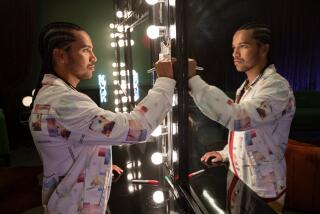Spicing a reggae recipe with potent R&B;
New York â Wayne Wonder has a way of upending American notions about reggae artists. He sports Gucci shades and a buzz cut instead of a T-shirt and dreadlocks, and he doesnât sing about Jah or Haile Selassie.
But his new album, âNo Holding Back,â a melange of reggae slow jams and R&B-inflected; pop tunes, just might turn Wonder, born Von Wayne Charles, into reggaeâs Next Big Thing.
This is a surprise, considering that the thin, placid crooner has been regaling Jamaica with ballads since he first recorded tracks with dub master King Tubby in the mid-â80s.
âIâm showing people that even though songs are dancehall, which is often grimy and hard-core, they can still be about love,â says Wonder, 30, as he lunches on curried chicken in the offices of Atlantic Records here.
Although generally classified as a dancehall artist -- the brand of reggae backed by electronic beats and designed for dance floors -- Wonder speaks softly, with a gentle lilt, of musical influences ranging from Otis Redding and Michael Jackson to reggae stars U-Roy and Bob Marley. He says that he reads Psalm 150 before writing his songs -- and he pulls a small book of Psalms from his back pocket and begins reciting with earnest sincerity.
Wonder loves New York, and during this recent week especially, New York loves him. His concert here was promoted by the cityâs biggest hip-hop station, and an album-release party drew lines around the block. Watching party footage on a camcorder, Wonder seems giddy at his success.
That success was triggered by the sudden crossover of another dancehall artist, Sean Paul. Last fall, Paulâs single âGimme the Lightâ was in continual radio rotation, and it revealed a recipe for bringing reggae to the masses: Start with dancehall, add generous doses of hip-hop and a remix with rapper Busta Rhymes, then garnish with a glossy video directed by hip-hop veteran Little X.
This recipe yielded a joint venture between Atlantic and reggae mainstay VP Records, then U.S. sales of half a million for âDutty Rock,â Paulâs album. Wonder, the reggae artist following in Paulâs VP/Atlantic footsteps, has also found himself a crossover hit, âNo Letting Go,â which has spent 12 weeks on Billboardâs Hot 100 singles chart and is in the Top 40.
But with its melodic hook and dulcet lyrics, âNo Letting Goâ does not evoke Sean Paul. Neither does Wonderâs take on the songâs video, shot in Ocho Rios, Jamaica: âItâs not about bling bling,â he says. âA new Benz will be old in five years, but the beach will always be the beach, the sun will always be the sun, and nature is forever. Thatâs my video.â
For years, only one crossover reggae artist -- Shaggy, with his blend of melodic pop and reggae -- succeeded in the United States. Now that Paul and Wonder have similarly found homes on mainstream radio, some see the start of a reggae renaissance, one that takes up where the early â90s -- when such dancehall artists as Patra and Shabba Ranks were signed to major labels -- left off.
Wonderâs been singing since his childhood in a Franklin Town, Jamaica, church, writing music since his teens, and producing since the early â90s, but he felt compelled to give Jamaican audiences what they love: versions of American tunes. His takes on R. Kelly and Tracy Chapman earned him a name, but, Wonder says, âI vowed in 1993 never to do another cover.â
He wrote all the songs on âNo Holding Back,â and with âNo Letting Goâ in heavy radio rotation, heâs reaping his reward. It all started with something called âdiwali.â
Named for a Hindu festival and created by Jamaican producer Steve âLenkyâ Marsden, diwali is the frenetic beat -- called a âriddimâ in Jamaican slang -- that backs âNo Letting Go.â The building blocks of dancehall, riddims get more attention in that world than individual songs, and they forge a certain musical democracy: Producers have dancehall artists perform over riddims, which can catapult even minor artists to radio play.
Countless reggae artists have recorded tracks on diwali, including Paul, whose latest diwali single, âGet Busy,â is the ideal radio prelude to âNo Letting Go.â Sharing a riddim, after all, boosts airplay of both singles.
âWeâve been paving the way for the last few years, proving to people that reggae can work in the American market,â says Michelle Lin, director of publicity at VP Records. âThe hip-hop generation gets that there is a whole new style of reggae out there, one that doesnât sound like Bob Marley, but weâre now starting to reach others, too.â
Hip-hop was born from Caribbean music, yes, but the challenge lies in making dancehallâs sheer energy trump its commercial liabilities: It is sung in Jamaican patois, and its riddim-based approach lends itself more to mix tapes featuring several performers than to albums by a single artist.
But with two very different artists in reggaeâs spotlight, itâs hard not to speculate about who might be next. During his week in New York, Wonder shared his concert stage with an artist Wonder himself first brought to the studio. Buju Bantonâs lyrical range -- he is both a DJ (in dancehall, that means a rapper) and an impassioned singer -- has made him a star in the dancehall scene, and his new VP album, âFriends for Life,â includes a track with New York rapper Fat Joe.
With dancehall going strong, Banton might just find himself a wider fan base. Todayâs industry, after all, is no longer looking for the next Bob Marley. Itâs looking for the next Sean Paul.
More to Read
The biggest entertainment stories
Get our big stories about Hollywood, film, television, music, arts, culture and more right in your inbox as soon as they publish.
You may occasionally receive promotional content from the Los Angeles Times.










